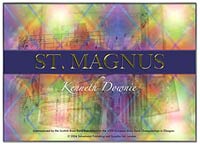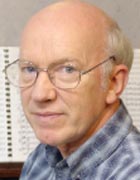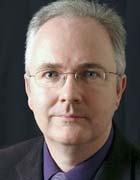2004 British Open Championships - The Test Pieces and the Composers
16-Sep-20044BR looks at the three test pieces for the bands this year, and finds out a little more about the composers who wrote them.
 St. Magnus - Kenneth Downie
St. Magnus - Kenneth Downie
Kenneth Downie has decided to test the bands at the European Championships with a set work entitled "St. Magnus" Variations for the European. It is available from SP&S publishers. Study scores will be available on the day of the contest.
This music is a set of variations on the tune known as St Magnus, which is attributed to Jeremiah Clarke. Most people will associate it with Thomas Kelly's hymn, which begins:
"The Head that once was crowned with thorns Is crowned with glory now".
The tune is very simple, consisting of just two, four-bar phrases. Neither is there much in the way of rhythmic variety, every note being a crotchet with the exception of two quavers, and the last note in each phrase. Within such a simple structure, however, lies considerable strength.
Theme:
The listener is given the opportunity of hearing it twice, in full, at the beginning, starting with one player but soon taken up by the full ensemble. It returns in the middle of the music and is stated again near the end. This has been done quite deliberately in the hope that there will be an appreciation of what material is being developed, by the listener as well as by those with access to the score, who are able to see the visual connections.
Variation 1:
This takes the rhythm of the last part of the theme and also uses the shape of the opening as a recurring figure. The mood is whimsical and skittish, with short, teasing rhythmic figures tossed around the band, and quick interplay with percussion, at a fast tempo. An energetic flourish finishes this variation before the Andante espress.
Variation 2:
This commences with chords related to the opening of Variation 1. The cantabile on solo cornets establishes a new, lyrical mood and there is scope for expressive playing in a series of short solo passages. The theme works its way unobtrusively into the texture before a reprise of the solo cornet melody and some more lyrical interchanges between Eb tuba, euphonium, flugel horn and cornets. The variation ends serenely with clear references to the last phrase of the theme.
Variation 3: Allegro con moto
The first idea to dominate is clearly linked to the shape of the theme's first phrase. There is a frenetic feel to much of this variation, with considerable energy and instability created by extensive use of cross-rhythms. A thinning-out of the score marks a clear change to development of the start of the second phrase of the theme. This proves to be short-lived however, and the opening material returns leading to a restatement of the theme, "Maestoso" after which a euphonium cadenza links to:
Variation 4:
Here we have some solos for euphonium, cornet, trombone and tuba set against a background of horns and baritones presenting a pensive statement of the theme's opening.
Variation 5:
This commences Allegro, with lively work for cornet and euphonium spreading to the whole band before attention focuses on the beginning of the second phrase of the theme which is initially presented in diminution, then in regular rhythm, then in inversion. An increase in tempo coupled with a decrease in volume, requires dexterity and control, with several metrical challenges thrown in for good measure. The same fragment of phrase becomes an ostinato which generates a frenzied climax, punctuated by short, dramatic silence, before the opening figure returns and the music gradually winds down.
The tubular bells herald the final return of the theme, in augmentation, marking the start of the:
Finale:
With the running semiquavers of the previous variation sounding in counterpoint. A fast, furious coda speeds the work to a conclusion while references to the opening of the theme are still trying to break into the texture of the music.
Kenneth Downie
 Kenneth Downie
Kenneth Downie
Kenneth Downie was born in Glasgow in 1946 and educated at Greenock High School, the Royal Manchester College of Music and Durham University. He then became a specialist music teacher in schools before finally leaving his position as head of music at Poole Grammar School to go into the jewellery business in 1976.
His published compositions, now numbering over 70, many of which has been recorded and broadcast on national radio, span a period of 30 years and are mainly for brass band or choir. In 1997 and 1999 his 'Purcell Variations' and 'Music for the Common Man' were chosen as section one regional test pieces for the National Brass Band Championships. In 2001 his 'St. Austell Suite' was the section three test piece.
In April 1998 he was appointed Composer in Residence to the Yorkshire Building Society Band and thus began a fruitful relationship involving concerts, broadcasts and recordings.
In July 2001 he was appointed creative music consultant to the Salvation Army, working for three days each week in the Music Ministries Unit of the Evangelism Department.
With his wife Patricia he established the music publishing company 'Kantaramusik' in 2001. Kenneth lives in Winchester with his wife Patricia, also a musician who teaches pianoforte and singing, and they are both active in the Salvation Army Church, Kenneth being Bandmaster and Patricia Songster Leader.
Kenneth's involvement in the Salvation Army Music Scene has afforded him the opportunity to travel throughout the world as, along with his wife, he has been involved in music schools and clinics in the USA, Canada, France, Sweden, and Holland.
The Scottish Brass Band Association were delighted when Kenneth accepted the commission of the 2004 European Championship test piece.
The music is a set of variations on the tune known as St Magnus, which is attributed to Jeremiah Clarke. Most people will associate it with Thomas Kelly's hymn which begins:
"The Head that once was crowned with thorns
Is crowned with glory now".
The tune is very simple, consisting of just two, four-bar phrases. Neither is there much in the way of rhythmic variety, every note being a crotchet with the exception of two quavers, and the last note in each phrase. Within such a simple structure, however, lies considerable strength.
The listener is given the opportunity of hearing it twice, in full, at the beginning, starting with one player but soon taken up by the full ensemble. It returns in the middle of the music and is stated again near the end. This has been done quite deliberately in the hope that there will be an appreciation of what material is being developed, by the listener as well as by those with access to the score, who are able to see the visual connections.
Montage - Peter Graham
Montage was commissioned by the All England Masters Brass Band Championships to be used for their contest in 1994, which was won by the BBS Fodens Band conducted by Howard Snell.
Peter Graham had written extensively for brass bands before he wrote Montage, but this composition represented a major shift in his compositional outlook and sought its inspiration from the likes of Lutoslawski and Messian. It is a three-movement work that lasts around 15 minutes in duration. The first movement intrada forms a perfect ABCBA arch. Generative thematic fragments appear in A above a pulsating timpani line which in turn is mirrored by the glockenspiel; B is characterised by glittering cornet work and figures whilst C is a sinuous duet punctuated by sharply descending semitones.
The middle movement is a beautiful detached chaconne, both expressive and melodic which revolves around a chord sequence, which builds to the climax of the whole piece. It is stated by the composer that the Chaconne's continuous cycle of chords maybe visualised as circles.
The final Rondo is full of drive and verve and moves towards a powerful conclusion, direct from the opening soprano and bass feature towards to very ending, which makes immense demands on player's stamina and technique. As stated in the foreword to the music: The teleological thrust of the movement (if not the entire work) can be symbolised by the flight of an arrow, as it steers a predetermined course towards it's target.
Since its use at the Masters Montage has proved a popular work and has been used extensively throughout Europe. In 1998 it was used as the regional test piece for the National Championships.
 Peter Graham
Peter Graham
Peter Graham was born in Lanarkshire, Scotland, where his introduction to music came through brass and piano lessons from his parents. He read music at Edinburgh University, graduating in 1980. During this period he came into contact with Ray Steadman-Allen and Edward Gregson, both of whom encouraged his early efforts at composition. He later undertook postgraduate compositional studies with Edward Gregson at Goldsmiths` College, University of London and holds a PhD in Composition.
From 1983 until 1986 he was resident in New York City, USA, where he worked as a freelance composer /arranger and as a publications editor with the S.A. Music Bureau. Since his return to the U.K. he has worked regularly as an arranger for BBC Television and Radio and has specialised in composition for the British style brass band. Since the publication of Dimensions (1983), he has carved out a niche as an outstanding arranger for brass bands, and a leading figure amongst contemporary band composers. His original compositions, which include The Essence of Time, Montage and On Alderley Edge, are performed worldwide and have been selected as test-pieces for National Championships in Australia, New Zealand, North America and across Europe.
His music for wind and concert band has been recorded and performed by many of the world's leading ensembles, including the Tokyo Kosei Wind Orchestra and the Royal Norwegian Navy Band. Harrison's Dream, commissioned by the United States Air Force Band, Washington D.C., won the 2002 ABA/Ostwald Award for composition. Commissioned by BMG/RCA Red Label to arrange and compose an album of xylophone music for virtuoso Evelyn Glennie, the resulting recording was nominated as Best Classical Crossover Album at the 1999 Grammy Awards held in Los Angeles.
He is published principally by Rosehill Music and Boosey & Hawkes, and since 1994 by his Gramercy Music, a company he formed together with his wife, Janey, which specialises in the publication of brass, wind and vocal music. Peter Graham is currently Reader in Composition at the University of Salford, Associate Conductor of the Black Dyke Band and in January 2004 he became the first civilian composer-in-residence of the Coldstream Guards Band. He also retains his early link with the Salvation Army, serving as a part-time consulting editor for their International Music Publications in London, England.
Contest Music - Wilfred Heaton
Contest Music was written in 1973 and was to be used as the test piece for the National Championships of Great Britain. It wasn't, and the decision not to use the work was quite simply a disgrace. It finally found favour with the organisers in 1982 and since that time it has widely been acknowledged as one of the very finest compositions for brass band ever written.
Ironically, the work was actually played at the Royal Albert Hall before that 1982 date, when the Swedish Band, Solna Brass conducted by G. Borkland used it as their own choice selection at the inaugural European Championships. Sine that time it has been played at very nearly every major brass band contest both in the UK and abroad.
The programme noted for the 1982 National Finals state that Contest Music follows a tradition of similar pieces for the brass medium by Elgar, Holst and Ireland in placing musical content first and instrumental virtuosity second. The music exists solely for itself and allies itself with 18th and 19th century classicism.
The work is in three movements - fast, slow, fast. In the outer movements the constant metamorphosis of material reflects classical procedures. The middle movement in contrast contains no development and is lyrical from beginning to end.
I. Adheres roughly to Sonata form, but the re-capitulation material is presented in inverted and reversed order.
II. Opens and closes with a tonally ambiguous dialogue between trombones moving harmonically and cornets in a single line. Between lies a continuously unfolding melodic line, restrained both dynamically and emotionally.
III. Is akin to the classical Rondo with a four fold statement of the main theme, its outline being changed and its pitch raised at each repetition.
John Wilfred Heaton (1918 - 2000)
John Wilfred Heaton was a composer of refined sensibility and technical skill the true extent of whose creative gifts has only emerged since his death in May 2000. As his many admirers suspected the music currently in print represents just a small part of what he actually composed. Wilfred's life in music was underpinned by wide-ranging interests in the arts in philosophy and by his strong religious background and faith. Yet at times during his long life his creative impulse was often tested and questioned.
Born in Sheffield to Salvationist parents Wilfred Heaton's musical talents were first nurtured through the Salvation Army. He began piano lessons at the age of 8. Soon after that he was learning the cornet and writing music of his own.
His piano teacher Salvationist songster Mrs Bennett guided him to his first musical milestone an LRAM in piano awarded when he was just 18. He left school to become an apprentice in a small brass instrument manufacturer and repair business in Sheffield. Apart from war service in the RAF he remained there for over 20 years composing whenever he could.
He noted on a manuscript page of his last work the autobiographical Variations "I got help initially from a crippled SA musician (George Marshall) who had a very sound harmonic instinct but who stressed contrapuntal studies above all then from a local music master who initiated me into the wider world of chamber and orchestral music and finally a lot later (the 1950's) Matyas Seiber whose instruction on Bach studies was invaluable. These are three with whom I had personal contact but along with other inspiring composers of the 18th century German giants and the 20th century masters".
It was expected that Wilfred would dedicate his musical talents to the Salvation Army and in his own words he continued to "do a good job" for the Army throughout his life. The technical and musical complexities of his best work whilst placing him firmly in the European classical mainstream were often thought to be too radical for Salvation Army performance. Those pieces that were published like the March Praise and the Meditation Just as I am have become firm Salvation Army favourites but several more were rejected. Others like Toccata eventually found their way into print many years later.
In his 20's and 30's Wilfred's musical ambitions extended beyond the brass band. There was a Suite for orchestra which later became a Piano Sonata and eventually the Partita for brass band. His Op.1 was a Rhapsody for oboe and strings - Op.2 was a suite of Three Pieces for piano. Both works received performances in London under the auspices of the Society for the Promotion of New Music. There was also a Little Suite for recorder (and flute) and piano composed in 1955 for the Sheffield based recorder virtuoso Philip Rogers. He also composed for chamber ensembles and voices.
In the late 1950's Wilfred's life began to take a different course. He had taken up the french horn and was working as a peripatetic brass teacher a move which in 1962 took the Heaton family to Harrogate. Wilfred played in a number of teachers' orchestras and ensembles. He was a founding conductor of the Dales Sinfonia. He formed and conducted the local schools orchestra. Between 1962 and 1969 he was Musical Director of the Leeds Symphony Orchestra and in 1970 he spent several months as Musical Director of the Black Dyke Mills Band.
However as his professional activities increased his own creativity went into decline. He continued to arrange music for the performing groups with which he was involved but he composed very little. Another note on the score of Variations offers the explanation "....all compositional ambitions were brought to a halt with my contact with Rudolf Steiner's Anthroposophical Movement. Involvement in this seemed to dry me up at a tempo. I lost the impulse to compose. Such an activity seemed unimportant compared with the spiritual impulses provided by Steiner". Most of his spare time was now dedicated to a systematic exploration of the worlds of philosophy and of spirituality.
From time to time he was tempted out of his creative semi-retirement most notably in 1973 when he accepted a commission to write Contest Music only for it to be rejected by the organisers as "too advanced". It was to be used to huge acclaim 9 years later as the test piece for the National Championships.
In his later years Wilfred was pleased but always appeared surprised at the appreciative reception his music was by then receiving. He never regained his old fluency but he was encouraged by family and close friends - notably the conductor Howard Snell - to take up his composing pen once again. After the death of his wife and his own retirement from teaching there was a welcome "Indian summer" - two substantial concertos two marches and his final Variations.
A few weeks before he died Wilfred Heaton remarked that as a young man all he wanted to do was be a composer "..... and I suppose that urge never really leaves you" he added. He once said to a colleague there would be some surprises at what would emerge from his " unregarded corner ". He was quite right.
Taken and reproduced from the website of the Wilfred Heaton Trust - www.wilfredheaton.fsnet.co.uk















